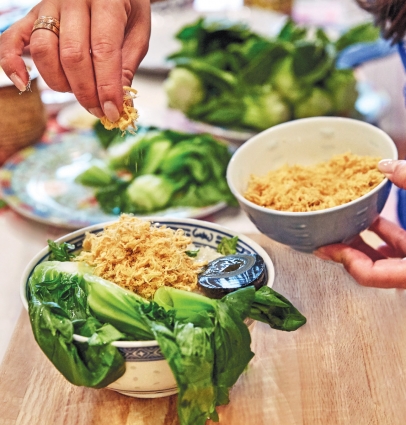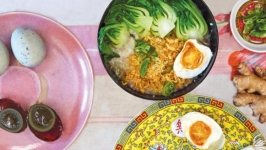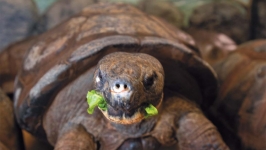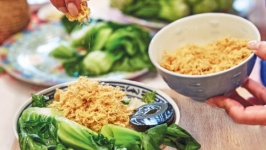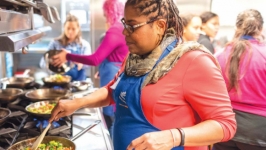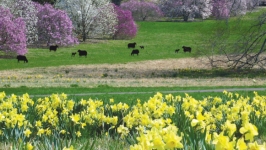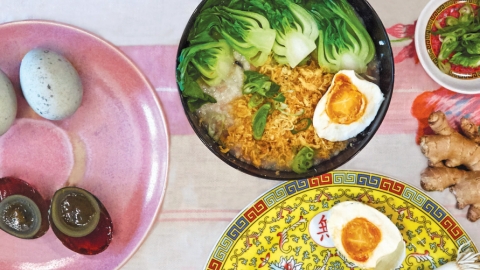Congee: The Ultimate Comfort Food
CONGEE IS A RICE PORRIDGE OF MANY NAMES and almost as many variations. It can be humble and luxurious. It is, in essence, rice cooked in copious amounts of water or broth, and it is the most comforting of all comforting dishes.
In the Philippines, spiked with calamansi and patis, it is arroz caldo, or hot rice. In Vietnamese, it is chao. Congee possesses the reputation of being a poor man’s dish and a sick man’s dish. There’s a Cantonese saying that a friend reminds me of as we eat bowl after bowl of congee in Philadelphia’s Chinatown: Hui sik jook, which translates to “going to eat congee.”
It’s a euphemism for being broke. “I’m poor, I can’t go out, so I’ll just head home and hui sik jook.”
Congee is inextricably tied to my Hong Kong upbringing. We interchangeably referred to it as jook, its Cantonese name, shi fan, its Mandarin name, and congee, its English name, which takes its root from Tamil. Like many Hong Kong families, mine switched between dialects of Chinese and English unthinkingly and frequently within a single sentence.
Congee was there at fancy Saturday brunches at the China Club, accompanied by many little white porcelain dishes of roasted peanuts, slivers of youtiao (fried dough), scallions, slices of pungent thousand- year-old eggs and silver-topped chopsticks to transfer as much of all that you desired into your own tiny bowl. Congee came in big, bland bowls at the cha chaan tengs in Wan Chai at breakfast, best eaten with a heaping portion of rou song (fried pork floss), egg and luncheon meat sandwiches, a youtiao the length of my arm and a strong cup of hot milk tea. Congee was at home, made from leftover rice in the rice cooker with water or chicken broth, sometimes for breakfast and always when anyone in the house had an upset stomach.
At Café Nhan on West Passyunk, I eat a bowl of oxtail congee (chao doui bo) for $10. It’s not on the menu, but as one of the owners, Nancy Vo, explains, she makes it whenever she gets fresh oxtail. Some of the oxtail is turned into broth for pho and some is reserved for congee. She sets down a large, steaming bowl in front of me, decorated with bean sprouts, fresh ginger, onion, shallots, cubes of pig’s blood and side dishes of lime wedges. There’s also sliced fried dough, called youtiao in Mandarin, meaning “oil stick” and yauh jha gwai in Cantonese, which translates to “fried oil ghost,” a name that dates back to the Song Dynasty and commemorates the general Yue Fei’s protest against the treasonous official Qin Hui. Yau jha gwai looks like a conjoined two-stick savory donut, representing Qin Hui and his wife; so, every day in China, Qin Hui and his wife are fried in effigy and eaten over and over.
I marvel over this congee at Café Nhan. It smells like pho. It is thinner than the congees I grew up on. Bean sprouts and lime are, to me, novel additions to a bowl that is otherwise familiar. Congee is a canvas, a malleable dish that reflects culturally specific ingredient combinations, establishments and even the families that make it.
Amongst the dish’s devotees, there is constant debate over what makes the perfect congee. Some people think it should retain the structure and integrity of whole rice grains, while others believe the grains of rice should disintegrate into the broth. I like my congee thick and fluffy with visible grains at home, but I expect it made into basically a paste when I eat out at cha chaan tengs (tea restaurants with Western influences popular in Hong Kong).
Congee is a canvas, a malleable dish that reflects culturally specific ingredient combinations, establishments and even the families that make it.
My parents, sister and I moved to Hong Kong from Honolulu in 1997, a month before the Handover back to China, though I had spent most of my summers and winters there before that. It was the home city of my mother, whose family, originally from Nanjing, first fled from the invading Japanese forces to Southwest China in the 1940s, then fled from the deteriorating political situation before the Communist Revolution to Taipei and then, eventually, to Hong Kong. And so Hong Kong also became my home city.
The Hong Kong I knew as a child slumbered for years after 1997, dreaming it was still a British colony even as it became known to the rest of the world as a Special Administrative Region of China. At school, my sister and I were educated by British, Canadian and Australian teachers. We drank Ribena with our congee and studied like schoolchildren in the UK did.
I grew up in a Hong Kong that was slow to awaken to a new governing power. My immediate family and most of my friends were apolitical. Political activity seemed pointless to most everyone around me, given that China selected who we could vote for anyway. This reality was shrugged off. Britain chose our governors, China chose our CEOs what was the difference? Life continued on after the Handover as it had before, though we now had a new flag and the most spectacular fireworks display to celebrate a newly declared Handover Day on July 1.
When I left for university, congee followed. My first couple of years abroad, in Florence and then in New York, I gravitated toward other international students, many of them from Asian countries and a few from Hong Kong. When I had the flu, my Hong Kong friend Ronald made me a big pot of congee, with no accoutrements, and delivered it to my dorm room. Accoutrements are for when congee is meant to be enjoyed, not for when it’s meant to nurse a girl with no appetite, a temperature and the distinct fear of hacking up a lung. Plain congee heals and nourishes and soothes.
Congee followed me to graduate school, where I made it in a single person’s crock pot and, since I was the only one eating it, added an inordinate amount of ginger and rou song. Congee reminds me of home but also brings comfort, allaying my guilt of living far away from home, far from my aging family.
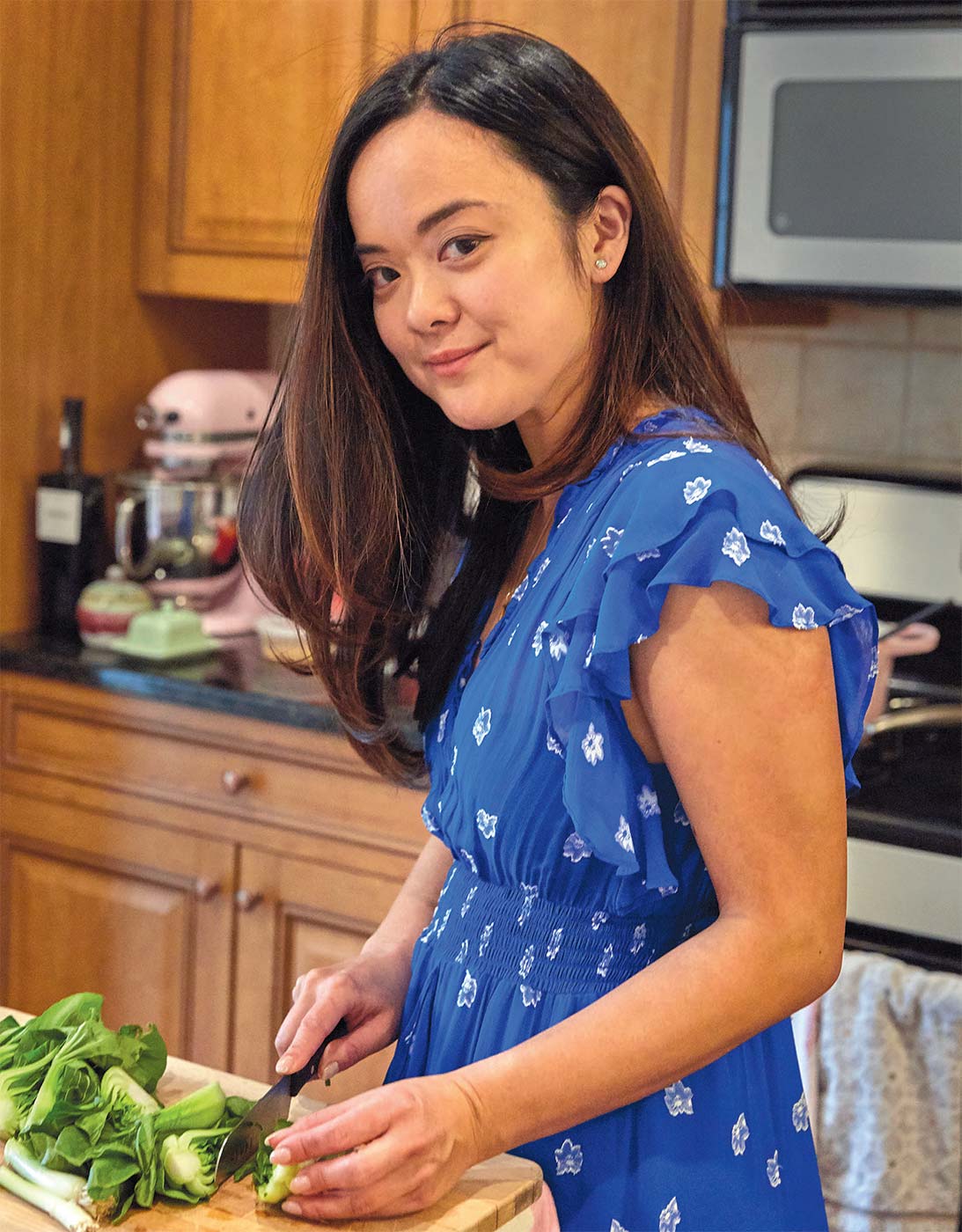
There is very little that reminds me of Hong Kong in Philadelphia. Between visits back to Hong Kong, it is easy to slip into my American forgetfulness of life anywhere else. Hong Kong, on the other side of the world, becomes a world away. Philadelphia’s Chinatown, to me, has little in common with the cosmopolitan city of my youth, where you have to search for remnants of an older Chinese city tucked between the gleaming seams and cracks of skyscrapers.
I head to Ting Wong in Philadelphia’s Chinatown on a wet, cold morning for bowls of roast duck congee and fish congee topped with roasted peanuts. I bring along a sick Ari Miller, chef and owner of Musi, determined to cure his cold with congee. Halfway through the fish congee, he asks, “So is congee made from broken rice grains?”
I cock my head at him. “It’s made from cooked rice!” I exclaim. Ari continues, “I wonder if you mill the fresh rice, you would get the same consistency, like with farina.”
There is a silence as I stare at Ari. “Why would you even think that?” I ask.
Philadelphia’s Chinatown, to me, has little in common with the cosmopolitan city of my youth, where you have to search for remnants of an older Chinese city tucked between the gleaming seams and cracks of skyscrapers.
In 2014, when Hong Kong people took to the streets in peaceful protests during the Occupy Hong Kong movement and held the attention of the world’s media, I and many other former Hong Kong kids who now live abroad were riveted to our television screens, obsessing over every news update, proud for the first time to declare that we were indeed from a city with a unified identity, with politics we might possibly control.
Many of us had left Hong Kong for university and never returned to live there. We were the Handover kids, our memories tied to a now fully dissolved British colony.
The protests of 2019 are a far cry from those of 2014, and this winter that I spend in Hong Kong is accompanied by far more turmoil and violence than I ever could have imagined taking place in my home city. Police in riot gear are fixtures on street corners during scheduled protests, laying in wait for the moment rhythmic solidarity transforms into chaos. Police vans block storefronts and cha chaan tengs that now abut boarded-up bank branches in Wan Chai and Central.
Hong Kong is often seen as a disparate collection of microclimates and expat enclaves, and just as everyone slips back into our daily lives and routines in between protests, we are collectively and abruptly jolted out of them, seeing or being the black-clad citizens that swarm streets, dodging tear gas. Now more than ever, we are aware that we can’t ever go back. Now more than ever, I crave comfort and respite from the notion that my home is a sinking ship. I carry my childhood with me and search for it with other displaced people of Chinese descent, and together we hui sik jook.
My Favorite Places to have Congee in Philadelphia
Bao-logy
1829 John F Kennedy Blvd.
215.999.2263
Baology.com
The most nutritious of breakfast congees is found here, made of forbidden rice in chicken stock with a soy-braised egg and optional toppings like pork belly.
David’s Mai Lai Wah
1001 Race St.
215.627.2610
Davidsmailaiwah.com
David’s congee is one of the most flavorful and reminiscent of those found at cha chaan tengs, dotted with small pieces of chicken and slices of green onion.
Ting Wong
138 N. 10th St.
215.928.1883
Tingwongrestaurant.com
Very fluffy sliced fish congee and roast duck congee are stars, but there are many varieties. The congee has a wonderfully starchy consistency and is the most austere in Philadelphia.
Café Nhan
1606 W. Passyunk Ave.
215.551.2407
Cafenhanphilly.com
Oxtail congee is not technically on the menu but frequently available. It comes with a little mountain of fixings: oxtail, beansprouts, pig blood, ginger, onion, fried shallots, lime.
M Kee
1002 Race St.
215.238.8883
A wonderful, large bowl of roast duck–topped congee is $7.50 and can last two meals. It’s flavorful, very Cantonese and on the thinner side of consistencies.


